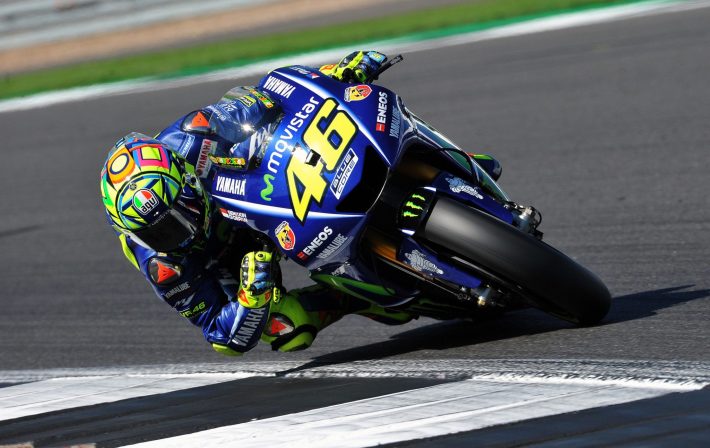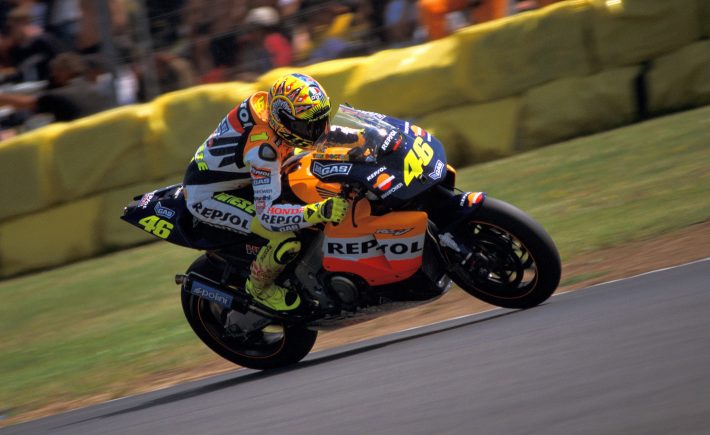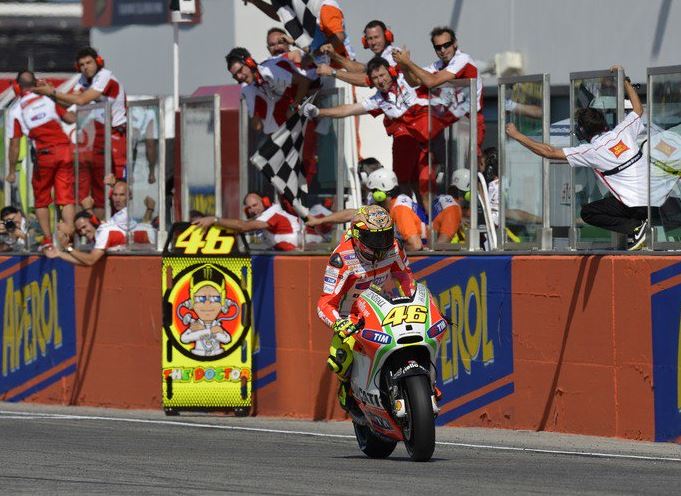Valentino Rossi’s 10 Career Defining Moments
With a staggering career at the top level that’s lasted for almost 25 years – and still going as strong as ever – Valentino Rossi has competed in more Grand Prix motorcycle races than anyone else, by some distance – at the end of 2017 he’d contested some 365 races.
We take a look at some of his career defining moments…
1996 – First Grand Prix win
With a year in the 1995 125cc European Championship, UK fans first got a glimpse of Rossi at Donington Park that year, when he finished fourth, going on to finish third overall in the championship.
The following year saw him remain with the Scuderia AGV team on a factory-supported Aprilia as he moved into the 125cc World Championship and whilst it was a mixed season, failing to finish five races and crashing several times, he took third in Austria and then at the following round at Brno in the Czech Republic, he claimed his first win.
Seven top six finishes in total enabled him to finish ninth overall and the best rookie.
1997 – World Champion
For 1997, Rossi gained full support from the factory Aprilia team with his RS125 now running in the colours of the Italian beer company, Nastro Azzurro, the start of a relationship that still exists today.
Having learned the ropes, and circuits, of the Grand Prix calendar, Rossi showed what lay ahead as he simply dominated the 125cc Championship.
Despite stiff competition from, amongst others, Noboru Ueda, Kazuto Sakata and Jorge Martinez, the Italian ran away with the title taking 11 wins from the 15 races and in the four he didn’t win, he took second, third and sixth.
With just one DNF, he clinched his first world title with three rounds to spare and some 83 points clear of Ueda.
Credit: Phil Wain’s Family Archive
1999 – 250cc success
After his maiden title success, Rossi moved up to the 250cc World Championship in 1998, continuing with the same team whilst the official Aprilia team comprised Loris Capirossi and Tetsuya Harada.
Just like his previous 125cc campaigns, the first season was somewhat of a learning year but this time he made more of an impression despite still only being aged 19.
That 1998 season saw him win five races and finish on the podium an additional four times to finish second to Capirossi by just 23 points.
That didn’t tell the whole story though as 5 DNF’s, to Capirossi’s single DNF, ultimately cost him the title.
For 1999, there were to be no such issues and, just as he had done in the 125cc class, he won the 250cc crown at his second attempt, winning nine races out of the 16 held.
With 12 podiums in total, he ended the year 48 points clear of Tohru Ukawa to take his second world title.
2000-2001 – the 500cc years
Having dominated both the 125cc and 250cc classes, it was only natural that Rossi would seek a move to the premier 500cc division in 2000 but with Aprilia not having a competitive machine it meant he had to move to a different manufacturer.
Five-time Champion Michael Doohan had retired during the 1999 season and Rossi not only inherited the Australian’s NSR Honda but also chief engineer Jeremy Burgess whose wealth of experience would prove crucial for the years ahead.
Doohan would also be involved with the team, still sponsored by Nastro Azzurro, acting as Rossi’s personal mentor in his first season.
Rossi made an inauspicious debut in 500s, failing to finish his first two races and then only managing a lowly 11th at round three.
However, the next two races saw him finish third and, at round nine in England, he claimed his first win with another win being taken in Brazil.
Indeed, the last eight races of the season saw him finish on the podium seven times and, like his previous seasons in 125 and 250, it would bode well for a stronger second season.
He finished second overall to Kenny Roberts jnr, 49 points adrift of the American, and the pattern of having a solid first year in a class followed by a year of dominance repeated itself in 500s as he pulverised the opposition during the 2001 season, winning 11 of the 16 races in the final year of the class.
He scored 325 points, a staggering 106 points ahead of Max Biaggi, to become just the second rider, after Phil Read, to win 125cc, 250cc and 500cc World Championships. He was the first and only satellite rider to clinch the 500cc title.
The new, four-stroke era was ushered in for 2002 with Rossi given one of the new RCV211V machines, this time as part of the official Repsol Honda team and he once more proved his adaptability as he promptly won the first two years of the newly-titled MotoGP class, adding another twenty wins to his rapidly growing collection.
2004 – Switch to Yamaha
After three successive titles with Honda, there was increased scepticism within the sport that Rossi – as good as he was – was only winning due to the dominance of the Honda machinery. Rumours had surfaced in 2003 that he wanted to prove otherwise and whilst Ducati looked like his initial choice of team, he passed up their offer to instead move to Yamaha.
It looked like a risky move as although the Yamaha M1 had run at the front on occasions, it seemed some way off the pace and competitiveness of the Honda.
Indeed, the best placed Yamaha in 2003 finished 7th overall, a mammoth 234 points adrift of Rossi.
Credit: Phil Wain’s Family Archive
The 2004 season started at Welkom in South Africa and it was a dream start for the new combination as Rossi won the race, becoming the only rider to win consecutive races with different manufacturers, having won the final race of the previous season on the Honda.
He went on to win another eight Grand Prix races that season, clinching the title at the penultimate round and ending the season 47 points clear of nearest challenger Biaggi.
With the critics firmly silenced, Rossi would win further world titles with Yamaha in 2005, 2008 and 2009 before making a sensational switch again for 2011.
2010 – Injury
After winning the MotoGP title for a seventh time in 2009, the 2010 season began with Rossi topping most of all pre-season testing sessions and he duly took victory in the first race of the season in Qatar.
However, he then injured his back and shoulder whilst training on a motorcross bike and team-mate – and now bitter rival – Jorge Lorenzo beat him at the next two rounds.
The injuries had expected to disappear after a few weeks but the damaged ligaments in his shoulder were taking a lot longer to heal.
They paled into insignificance to what happened at his home round at Mugello in June when a 120mph crash left Rossi with a compound fracture of his right tibia.
Not only was this the first major bone Rossi had broken during his career, it was the first time he’d missed a Grand Prix since making his debut in 1996, a phenomenal run of fourteen and a half seasons.
A lot of debate took place as to how he’d bounce back after suffering the break and he eventually made his comeback in Germany only 41 days after the accident.
He took fourth place but added seven more podiums in the second half of the season, including a win in Malaysia, to finish third overall and prove returning from injuries was no barrier to success.
2011-2012 – the Ducati Years
In August 2010, Rossi made the sensational announcement that he would be calling time on his seven year stay at Yamaha and making the move to Ducati.
The two-year deal would start in 2011 and with an Italian rider – the best on the planet – on an Italian bike, it was a dream partnership for not only the manufacturer but for the country itself.
The Ducati had proven to be a troublesome machine for many who had previously ridden it though and only Casey Stoner, seemingly, had the ability to consistently run at the front and win races, the Australian having won the world title in 2007.
Credit: Phil Wain’s Family Archive
Rossi, with his exceptional talent, was expected to be an instant hit on the Ducati and dispel the notion that only Stoner could win on it.
Right from the off, when he was almost two seconds off the pace in testing, it was clear there were issues though, ones that even Rossi and Burgess couldn’t overcome.
Try as they might, the now 32-year old and his crew chief simply couldn’t find a way to make the Ducati work for them and third in France was their only podium of the season.
For the first time in his Grand Prix career, he ended the year winless as he finished a disappointing seventh overall over 200 points adrift of Stoner who took his second world title, this time on the Repsol Honda.
With a full season on the Desmosedici under his belt, Rossi was expected to make a much better fist of things in 2012 but although he took another podium at Misano, more often than not he was battling for positions at the lower end of the top ten and Assen was the ultimate lowpoint as he only finished 13th.
The end result was sixth overall in the standings and the sorry two years came to an end, having made the decision mid-season to rejoin Yamaha.
2013 – Return to Yamaha
With his Ducati dream having turned into a nightmare, Rossi realised if he was to challenge for a tenth world title, he needed to move teams once more.
In August 2012, he announced he would be leaving the Italian concern to resume his relationship with Yamaha where he’d once more have Jorge Lorenzo as his team-mate.
Of course, after two ‘damaging’ years on the Ducati and at 34 years of age, many were keen to see if Rossi could get back to his previous levels and maintain the desire and will to win.
He also had a new challenge to deal with in the shape of Marc Marquez.
All doubts about Rossi’s desire disappeared immediately as he took second at the opening round and although he wasn’t able to show the sort of dominance he’d shown in the early years of MotoGP, primarily due to the levels of competition, June that year saw him back on the top step of the podium as he won the Dutch TT at Assen.
Three more podiums were take as he finished fourth overall but with Marquez, Lorenzo and Dani Pedrosa ahead, he knew he needed to dig deep and step up a gear if he was ever to seriously challenge them again.
Changes were subsequently made behind the scenes as Rossi dispensed with the services of Jeremy Burgess who’d been with him since his maiden year in the premier class in 2000.
Most of the critics thought this was a mistake but Rossi took second overall in 2014 to firmly prove he’d risen to the challenge thrown down by Marquez and co.
2015 – Clash with Marquez
Rossi started the 2015 seasons – his 20th at World Championship level – by taking victory in the opening race in Qatar, his first win in a season-opening race since 2010.
Another win came in Argentina and with the podiums flowing, he was back to his best and back challenging for the MotoGP world title.
Victory at Silverstone saw him retake the championship lead from Lorenzo and although he could only finish fifth at Misano, he extended his lead to 23 points – his aim for a tenth world title, and eight in the 500cc/MotoGP class, was very much on.
Over the next few rounds, Lorenzo chipped away at Rossi’s advantage and after the penultimate round in Malaysia, the gap was just seven points with one round to go.
But that didn’t tell the whole story about Malaysia as Rossi clashed with Marquez, the latter controversially crashing out.
Rossi finished third but had to start the final round from the back of the grid and although he made it through the field to fourth, Lorenzo won to take the title by five points.
The fall-out after the clash with Marquez was considerable as words were exchanged between numerous parties and, for a while, MotoGP lost some fans as it came under the microscope.
2017 – Still winning
2017 marked the start of Rossi’s 22nd year of competing in the World Championship and after finishing second overall for the previous seasons he was more determined than ever to take that elusive world title number ten.
For the first half of the year he remained very much in contention and victory at Assen put him just seven points off the title lead in what was shaping up to be one of the closest season ever.
However, a crash on a motorcross bike in training left him with a broken leg once more and his chances disappeared. Miraculously, the 38-year old only missed one GP and took fifth on his comeback in Aragon whilst second in Australia proved that the GOAT – the greatest of all time – remains exactly that.



